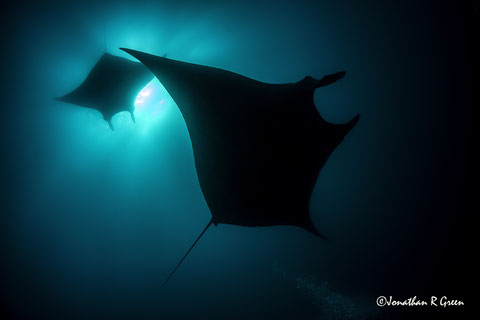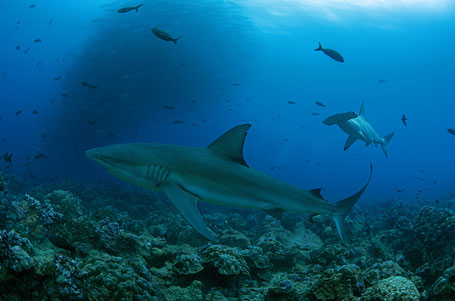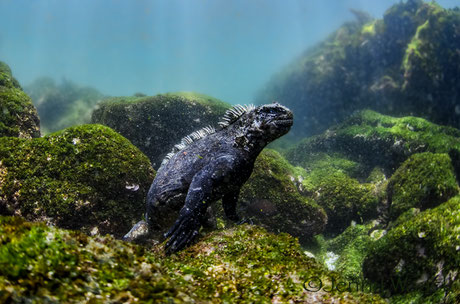Special 15 day Galapagos Itinerary
Every week, every day dive and water conditions change in the Galapagos Islands. If you decide for the 15 day / 14 night liveaboard dive experience you will double your chance to see the wildlife you are coming for - hundreds of hammerhead sharks, whale sharks, marine iguanas, sunfish - and so much more!
This Special 15 day itinerary still requires the approval of the national park. This approval takes place in March of the respective year and is intended to ensure that only a certain number of guests are in one place on one day. The travel route can therefore be subject to minor changes.
Tuesday
Morning: Santa Cruz - Baltra Airport
Afternoon: Baltra (1 check dive) & Land excursion to North Seymour
Wednesday
Morning: Pinzon & Roca Blanca (2 dives)
Afternoon: Chinese Hat Island (land visit)
Thursday
Morning: Cape Marshall (2 dives)
Afternoon: City of Mantas (1 dive)
Friday
Morning: Wolf Island (2 dives)
Afternoon: Wolf Island (2 dives, including night dive)
Saturday
Morning: Wolf Island (2 dives)
Afternoon: Darwin's Arch (1-2 dives)
Sunday
Morning: Darwin's Arch (2 dives)
Afternoon: Darwin's Arch (1-2 dives)
Monday
Morning: Darwin's Arch (2 dives)
Afternoon: Darwin's Arch (1-2 dives)
Tuesday
Morning: Darwin's Arch (2 dives)
Afternoon: Darwin's Arch (1-2 dives)
Wednesday
Morning: Darwin's Arch (2 dives)
Afternoon: Darwin's Arch (1-2 dives)
Thursday
Morning: Wolf Island (2 dives)
Afternoon: Wolf Island (1 dive)
Friday
Morning: Roca Redonda (2 dives)
Afternoon: Punte Vicente Roca (1-2 dives)
Saturday
Morning: Punte Vicente Roca (2 dives)
Afternoon: Land excursion to Punta Espinoza on Fernandina Island
Sunday
Morning: Land visit to Tagus Cove
Afternoon: Cape Douglas (2 dives)
Monday
Morning: Cousin's Rock (1 dive) & land visit Bartolome
Afternoon: Santa Cruz - land excursion to the Highlands with Giant tortoises
Tuesday
Morning: Baltra Airport depart or continue with land extension

DAY 1 - TUESDAY - BALTRA ISLAND -Arrival , transfer & Check Dive
AM - Baltra Island
Guests fly to the Galapagos Islands from mainland Ecuador, arriving in the late morning. The GWSP dive masters and yacht dive master/naturalist guide will be waiting at the airport on Baltra Island. Once the group has collected their luggage and cleared the National Park immigrations we will board the Yacht which will be anchored in the port 10 minutes travel by bus. After everyone has settled in their cabins the guides will give a briefing on ship life, national park rules and diving safety, whilst the galley crew prepare the dining room for a delicious buffet lunch.

PM - Baltra (Check dive, equipment and weights)
After a briefing on the dive platform all equipment should be set up in readiness for the test dive. This will be at a nearby anchorage in calm shallow waters. Maximum depth of 12m. Although plentiful fish and usually sea lions and other species are to be seen, the objective is to check weight and equipment for the following days.
PM - North Seymour (land visit)
This place is the reason for many travellers and ornithologists to observe the spectacular and diverse amount of birds of the Galapagos.
North Seymour is a fascinating place with open nesting grounds of blue-footed Boobies and the archipelago’s largest colonies of Great and magnificent Frigate birds. Blue-footed Boobies perform their courtship dance in the more open areas; Swallow- tailed Gulls perch on cliff edges; Great Blue Herons, Lava Herons, two species of frigate birds, and endemic snakes can also be spotted.
You’ll find endemic land iguanas 3.9 ft (1.20 m) in length. Despite the tremendous surf pounding the outer shores, sea lions haul their slick bodies onto the beach and can be found together with marine iguanas. The vegetation is sparse and typical of arid zones.

DAY 2 - WEDNESDAY: PINZON, ROCA BLANCA & CHINESE HAT
AM - Pinzon & Roca Blanca (2 Dives)
These remote islands offers diving with many different wildlife. You might encounter cownose rays & other rays, turtles, hammerheads and 6 other different shark specieas, sea lions, moray eels, lobsters, grunts, surgeonfish, scorpionfish, and the endemic Galapagos garden eel. One of the most exciting things you can spot here are the bait balls of Salemas, big schools of rays and Giant manta rays, with a wingspan of up to 7m.
PM - Chinese Hat Island (land excursion)
Despite its small size, Chinese Hat Island offers unforgettable views and an incredible contrast between its beach, volcanic landscape, and clear waters. From the island's lookout, enjoy breathtaking panoramas extending to Santiago and Bartolome islands.
Wildlife enthusiasts will love the sea lion colony, marine iguanas, Sally Lightfoot crabs, shorebirds, and the chance to spot Galapagos penguins. Snorkeling here reveals whitetip reef sharks, sea lions, and colorful fish.
Visit Chinese Hat Island for its stunning scenery, diverse wildlife, and excellent snorkeling opportunities.

DAY 3 - THURSDAY: CAPE MARSCHALL / CITY OF MANTAS
AM & PM - Cape Marshall (2 - 3 Dives)
This area on the northeast side of Isabela island offers a few great dive spots. One of them is Cape Marshall, also called 'Ciudad de las Mantas' (City of Mantas),
named for how common it is to see giant mantas. The plankton-rich waters of this area are an attraction for many species of rays - like the eagle ray or giant manta, white tip sharks, sea lions,
green sea turtles and many more. The topography is beautiful and invites divers to enjoy their first dives in the Galapagos Islands.
DAY 4 & 5 (AM) - FRIDAY & SATURDAY AM: WOLF ISLAND
Friday: AM & PM - Wolf Island (3 - 4 dives)
Saturday: AM - Wolf Island (2 dives)
The powerful marine currents around Wolf are part of the reason we see so many sharks. Schooling hammerheads, Galapagos sharks, Black tip and Silky sharks are the usual protagonists. Dolphins are often present as we end our dives with a drift in the blue.
Two turtle species, the Green and Hawksbill are frequently sighted along the rocky walls and slopes of this island. Eagle rays and large schools of fish, snappers, grouper and jacks patrol the drop-off.
Depending on the conditions we will offer a night dive in Wolf Island on Friday.
Wolf island is home to vast numbers of sea birds, Red footed and Nazca Boobies, frigate birds, the endemic Swallow – tailed gull and the elegant Red – billed tropicbird. Finches and doves are often spotted hoping amongst the rocks.

DAY 5 (PM) - 9 - SATURDAY TO WEDNESDAY: DARWIN'S ARCH
Saturday: PM - Darwin Island (1 - 2 dives)
Sunday to Wednesday: AM & PM - Darwin Island (3 - 4 dives per day)
We will spend whole 4,5 days up in Darwin Island, far in the north of the Galapagos Islands. Darwin's Arch is the most famous and most impressive dive spot of the Galapagos. Per day we will offer 3 - 4 dives. All dives are at the same site, the world renowned Darwin Arch. We drop on to a rocky ledge and from a protected position watch the marine life swim by. Hammerhead and Galapagos sharks, Black tips and Silkies. Marine turtles abound and Bottlenose dolphins often pass by overhead.

Huge schools of fish, tuna, jacks and Creole fish swim in the blue whilst dozens of other species inhabit the coral covered platform and ledges.
This is also the realm of the biggest shark of them all, the Whale shark. Frequenting the Islands between June – December over 95% of all sightings occur here at the Arch. Of these a staggering 99% are female and in an apparent state of advanced pregnancy. Why they come to this rocky volcanic outcrop remains a mystery and one that the Galapagos Whale Shark Project team is trying to solve.

DAY 10 - THURSDAY: WOLF ISLAND
AM & PM - Wolf Island (3 dives)
Another full day exploring the diverse dive sites of Wolf. The dives may take us to the swim through arches and along the spectacular walls and cave entrances. Again the local conditions will decide which are the best options dependent on current and swell. More time to observe the sharks and marine megafauna or study the massive diversity of life that inhabits the large coral heads and boulder slopes. Towards evening we set sail for the north of Isabela Island.

DAY 11 - FRIDAY: ROCA REDONDA & PUNTE VICENTE ROCA
AM - Roca Redonda (2 dives)
On our way south to the western side of Isabela we will stop in Roca Redonda. The underwater fumaroles towards the southeast face of the islet are quite picturesque. One can witness bubbles created by steam rising to the surface of the water which makes one think that the volcano beneath the water surface might still be active.

PM - Punte Vicente Roca (1 - 2 dives)
Afterwards on our way south we are planning 1-2 afternoon dive(s) in Punte Vicente Roca. The wall is one of the most diverse of all Galapagos for marine invertebrates and is one of the favourite sites for macro photography. Brightly coloured blennies, Long nose coral hawkfish, frogfish and sea horses can be found amongst the solitary corals, anemones, tunicates and sponges. Green sea turtles are present all year and whales are often spotted in these waters.
DAY 12 - SATURDAY: PUNTE VICENTE ROCA & PUNTA ESPINOSA
AM - Punte Vicente Roca (2 dives)
This morning we will dive at Punta Vicente Roca. Best known for the frequent sightings of Mola alexandrini, the southern ocean sunfish. The Molas approach the wall to visit the cleaning stations where wrasses and angelfish await. Sea lions and Galapagos fur seals abound and often follow divers playing with bubbles and darting in and out of schools of sardine sized Brown striped Salemas.
The wall is one of the most diverse of all Galapagos for marine invertebrates and is one of the favourite sites for macro photography. Brightly coloured blennies, Long nose coral hawkfish, frogfish and sea horses can be found amongst the solitary corals, anemones, tunicates and sponges. Green sea turtles are present all year and whales are often spotted in these waters.

PM - Punta Espinoza (1 land excursion)
After our morning dives we will be sailing to Fernandina Island across the Bolivar channel which is an excellent opportunities for whale and dolphin watching. Showcased by many documentaries including BBC’s Blue Planet I & II, Fernandina Island is home to the world’s largest marine iguana colony. The island is also one of the most pristine islands in the world, with none of man’s introduced species to date. The flat jet-black lava of Punta Espinosa is a defining feature of its stark and barren landscape. Other features are lava cacti, black, white and red mangrove, Sally light-foot crabs, Galapagos hawks, and sea turtles. Moreover, the famous flightless cormorant inhabits this island. This a land visit you don't want to miss out!

DAY 13 - SUNDAY: TAGUS COVE & CAPE DOUGLAS
AM - Tagus Cove (1 land excursion)
In the early morning we will offer a beautiful hike in Tagus Cove. Tagus Cove is located on the Northwestern coast of Isabela. It is a historical site visited by Charles Darwin in 1835. The hike will bring us to a view point over the dramatic volcanic landscape of Isabela Island with views of Darwin Crater Lake. In Tagus Cove also can be found 7 different species of Darwin finches.
We will return by the same path for a dinghy ride along a shoreline full of marine wildlife. Here, we will admire a variety of seabirds, such as blue-footed booby, brown noddy, terns, flightless cormorant and Galapagos penguins. The Galapagos penguins are only 1.4 ft. tall (35 cm) and are the only penguin species in the world living in the northern hemisphere, that is, along the Equator.
PM - Cape Douglas (2 dives)
Cape Douglas, showcased by many documentaries including BBC’s Blue Planet I & II, this is where marine iguanas are to be found feeding in the shallow bays between 5-10m. A unique experience that can only be had in the Galapagos we also find the endemic flightless cormorant and Galapagos penguins feeding here.
DAY 14 - MONDAY: COUSIN'S ROCK & BARTOLOME & SANTA CRUZ HIGHLANDS
AM - Cousin's Rock (1 Dive)
In Cousin's Rock we often find playful sea lions, Eagle rays, Golden rays and sometimes Mobula and Giant Pacific manta rays. The underwater topography provides refuge for sleeping turtles and white tip sharks whilst the steep walls are covered by marine invertebrates.

Two species of black coral, sponges and colonial tunicates are a colourful backdrop for the abundant fish that frequent this emergent volcanic cone.
The currents often found here attract some of the larger shark species such as hammerheads and black tip sharks. Amongst the corals we sometimes find Pacific golden sea horses and frogfish.
AM - Bartolome (1 land excursion)
After our morning dive we will offer a land visit to the famous Bartolome Island - the most iconic place in the Galapagos!
We will travel back in time to the formation of lava tubes, spatter cones and the remains of two types of hardened lava: AA and pahoehoe. Beautiful and breathtaking landscapes as you climb up Summit Trail. During the ascent, visitors will see Tiquilia and various cactus species, which add to the unique experience. The tall, leaning spike known as Pinnacle Rock is always something to behold. The Pinnacle Rock, formed by an eroded toba cone, is the most emblematic formation of the archipelago. On its base, a small colony of Penguins cohabit with Sea Lions and Marine Birds.


PM - Santa Cruz - Highlands with Giant tortoises
After the dive in Cousin's Rock & land visit in Bartolome we will head to Santa Cruz Island. Here we visit the highlands of Santa Cruz to see Giant tortoises in the wild. On our visit we also will make a stop at a lava tunnel and often mistaken for volcanic craters, Los Gemelos – or “The Twins” in English – are actually sinkholes.

DAY 15 - TUESDAY: BALTRA AIRPORT
AM - Santa Cruz - Baltra Island / airport
Assisted by the naturalist guide and some crew members, the dinghy will bring you and your luggage to Baltra, where we will take the airport shuttle. Your guide will accompany you to the check-in counters in the departure hall.
This is certainly one adventure that will change your lives and you will remember forever... until you return perhaps?












